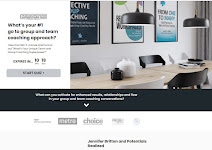Group Facilitation Tip - Visual Learning
Copyright 2007 - Jennifer Britton
Did you know that almost 60% of adult learners are primarily visual learners? This means that they have an affinity for seeing things in order to learn. How do you enable participants to access the visual side of things in your group programs?
Whether it is a workshop, retreat or group coaching program, here are some suggestions for supporting the visual learners in your programs:
1. Provide a particpant's notebook or other handout, where participants can see and follow along what you are discussing. Participant's notebooks and handouts can serve additional purposes, including:
* capturing the main learning points for people to take forward
* a marketing tool - include your contact details, bio and any other information on upcoming programs that may be applicable to the group
Take a look at a post from early 2006 entitled "The Power of a Takeaway"
2. Provide small discussion groups with a piece of flipchart paper so they can capture the key points they have discussed. These can be shared with the larger group, and then posted on the walls for future reference.
3. One of my favorite closure activities is the Gallery Walk. During this exercise, each participant is given several minutes to walk around the room where the program is being held and look at all of the flipcharts which have been created during the workshop. I often set up this activity by asking participants to come up with a list of their top three learnings, or top three action items.
4. Another tip I usually introduce to participants is the importance of writing things down. Physiologically our brain gets imprinted as we move through the simple act of writing. Writing things down becomes a reference for the future, helps to keep people focused, and also supports the brain learning function!
5. Use visual aids - Powerpoint (sparingly! as I indicated in my Death by PowerPoint article), flipcharts, photos and other props to make things memorable. When developing exercises, also consider how participants can create "visual output" such as collages, drawings, vision boards, rather than just verbal discussion.
What other methods do you use to support visual learners in your programs? What ideas will you incorporate into your next program? I'd love to hear your thoughts -- please feel free to comment below.
Have a wonderful week,
Jennifer
Jennifer Britton, PCC, CPCC, CHRP, CPT
Potentials Realized
Group Coaching Essentials
Toll Free: 1-866-217-1960
Email: jennifer{at} potentialsrealized{dot}com
Subscribe to:
Post Comments (Atom)












No comments:
Post a Comment